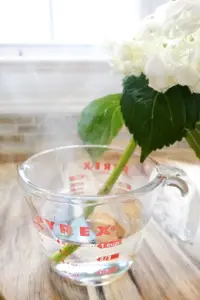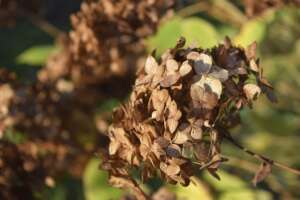Table of Contents
 Hydrangeas are prized for their breathtaking blooms and ability to transform any garden into a vibrant oasis. However, these lovely plants sometimes suffer from wilting, lackluster blooms, or overall distress.
Hydrangeas are prized for their breathtaking blooms and ability to transform any garden into a vibrant oasis. However, these lovely plants sometimes suffer from wilting, lackluster blooms, or overall distress.
If your hydrangeas show signs of struggle, fear not! You can revive these magnificent flowers and restore them to their former glory with a little care and attention.
This comprehensive guide will take you through the step-by-step process of reviving hydrangeas, ensuring they survive and thrive. From assessing the health of your hydrangeas and managing moisture levels to correcting soil imbalances and providing proper pruning techniques, we will cover every aspect of nurturing these stunning plants. Whether you’re a seasoned gardener or a beginner, this guide will equip you with the knowledge and techniques needed to revive your hydrangeas and enjoy an abundance of magnificent blooms.
Step-By-Step Guide For Revive Hydrangeas
| Step | Actions |
| 1 | Assess the health of your hydrangeas |
| – Look for signs of distress | |
| – Identify the specific hydrangea type | |
| – Check soil conditions and drainage | |
| 2 | Watering |
| – Water deeply and thoroughly | |
| – Avoid shallow watering | |
| – Provide 1 inch of water per week | |
| – Mulch to retain soil moisture | |
| 3 | Correct soil imbalances |
| – Understand pH levels and adjust accordingly | |
| – Ensure nutrient-rich soil | |
| 4 | Pruning and shaping |
| – Prune at the appropriate time and technique | |
| – Remove dead or damaged branches | |
| – Shape the plant for fuller appearance | |
| 5 | Sunlight and shade considerations |
| – Determine ideal sunlight requirements | |
| – Provide shade or cover during extreme weather | |
| – Choose suitable planting locations | |
| 6 | Fertilization and nutrient supplements |
| – Select appropriate fertilizers | |
| – Follow recommended frequency and timing | |
| – Consider micronutrient supplementation | |
| 7 | Pest and disease management |
| – Identify and control common pests | |
| – Use natural or chemical methods | |
| – Recognize and treat hydrangea diseases |
Assessing the Health of Your Hydrangeas
To successfully revive your hydrangeas, assessing their overall health and identifying any underlying issues is crucial. By closely examining your plants, you can determine the root causes of their distress and tailor your care accordingly. Here are some essential steps to assess the health of your hydrangeas:
Signs of distress and common causes: Look for wilted or yellowing leaves, stunted growth, or sparse blooms. These symptoms can indicate problems such as inadequate watering, nutrient deficiencies, pest infestations, or improper pruning.
Identifying the specific type of hydrangea: Different hydrangea varieties have distinct care requirements. Take note of the specific type of hydrangea you have, whether it’s a mophead (Hydrangea macrophylla), lace-cap (Hydrangea serrata), or another variety, as this will inform your care strategies.
Examining soil conditions and drainage issues: Hydrangeas thrive in well-draining soil. Check if the soil is compacted, waterlogged, or lacking organic matter. Poor drainage can lead to root rot and other detrimental effects on plant health.
By carefully assessing the health of your hydrangeas, you can pinpoint their specific challenges and proceed with targeted remedies to revive them successfully.
Watering and Moisture Management
Proper watering and moisture management are crucial for reviving and maintaining healthy hydrangeas. These plants have specific water requirements that, when met, ensure optimal growth and vibrant blooms. Here’s a breakdown of essential aspects to consider:
- Proper watering techniques: Hydrangeas prefer moist soil but are susceptible to root rot if overwatered. Water deeply and thoroughly, ensuring the entire root zone is moistened. Avoid shallow watering, as it can lead to shallow root growth.
- Determining the right amount of water: The water needs of hydrangeas vary based on factors such as temperature, humidity, and soil type. Generally, aim to provide around 1 inch of water per week during dry periods. Adjust watering frequency and amount based on weather conditions.
- Mulching for moisture retention: Apply a layer of organic mulch, such as bark chips or compost, around the base of the hydrangea plants. Mulching helps retain soil moisture, regulates soil temperature, and suppresses weed growth. Maintain a mulch layer of about 2-3 inches, keeping it a few inches away from the plant’s stem to prevent rot.
Mulching and Its Benefits For Moisture Retention
Mulching is a gardening practice that involves applying a layer of organic or inorganic material around the base of plants. Regarding hydrangeas, mulching offers several benefits, particularly moisture retention.
Here’s an explanation of the benefits of mulching for moisture management:
- Retaining soil moisture: One of the primary benefits of mulching is its ability to retain moisture. The layer of mulch acts as a barrier, reducing water evaporation from the soil surface. This helps maintain a consistent moisture level around the roots of hydrangeas, preventing them from drying out.
- Regulates soil temperature: Mulch also helps to regulate soil temperature, keeping it cooler during hot summer months and warmer during colder periods. By insulating the soil, mulch minimizes temperature fluctuations that can stress hydrangea roots and impede their ability to absorb water efficiently.
- Suppresses weed growth: Weeds compete with hydrangeas for water and nutrients. Mulching effectively suppresses weed growth by blocking sunlight and preventing weed seeds from germinating. This reduces the competition for water, ensuring that hydrangeas receive most of the available moisture.
- Prevents soil erosion: During heavy rainfall or watering, bare soil can easily erode, leading to water runoff and loss of moisture. Mulch acts as a protective layer, reducing soil erosion by slowing down the flow of water and allowing it to be absorbed more effectively by the soil.
- Improves soil structure: Organic mulches, such as bark chips or compost, gradually break down. As they decompose, they enrich the soil with organic matter, improving its structure and water-holding capacity. This further aids in moisture retention around the hydrangea roots.
Pruning and Shaping Hydrangeas
Pruning and shaping hydrangeas are essential for maintaining these beautiful plants’ health, appearance, and blooming potential. Here’s an explanation of pruning and shaping hydrangeas:
Timing and techniques for pruning: The timing of pruning depends on your specific hydrangea variety. Generally, there are three main categories of hydrangeas in terms of pruning requirements:
- Hydrangea macrophylla (Mophead and Lacecap): These varieties bloom on old wood, meaning the flower buds form on the previous season’s growth. Prune them immediately after flowering or in early spring before new growth emerges.
- Hydrangea paniculata (Panicle Hydrangeas): These hydrangeas bloom on new wood, meaning the flower buds develop on the current season’s growth. Prune them in late winter or early spring before new growth starts.
- Hydrangea arborescens and Hydrangea quercifolia: These varieties also bloom on new wood. Prune them in late winter or early spring before new growth begins.
Removing dead or damaged branches
Regularly inspect your hydrangeas for dead, diseased, or damaged branches. These should be pruned off at their base to prevent the spread of diseases and to encourage new growth.
Promoting healthy growth and encouraging blooms through shaping
Pruning can also help shape your hydrangeas and promote bushier growth, leading to more blooms. Here are some shaping techniques to consider:
- Pinching: Pinching involves using your fingers or pruners to remove the tips of new growth. This encourages branching and results in a fuller appearance. Heading back refers to selectively pruning branches back to a desirable length. This can help control the size of the plant and promote a more compact and tidy shape.
- Thinning: Thinning involves removing entire branches or stems from the plant to improve air circulation, reduce overcrowding, and allow more light to reach the inner parts of the plant. This can help prevent disease and promote overall plant health.
- Renewal pruning: For older or overgrown hydrangeas, renewal can be done by removing one-third of the oldest stems at the base each year for three years. This rejuvenates the plant and encourages new growth.
Sunlight and Shade Considerations
Sunlight and shade considerations are crucial factors in ensuring hydrangeas’ optimal growth and blooming. Here’s an explanation of how to manage sunlight and shade for hydrangeas:
Ideal sunlight requirements
Hydrangeas thrive in different levels of sunlight depending on the variety. Understanding the sunlight preferences of your specific hydrangea species is essential. Here are some general guidelines:
- Full Sun: Some hydrangea varieties, such as Panicle Hydrangeas (Hydrangea paniculata) and Smooth Hydrangeas (Hydrangea arborescens), tolerate and even enjoy full sun exposure. These varieties typically require at least 6 hours of direct sunlight daily for optimal growth and blooming.
- Partial Shade: Many hydrangea varieties prefer partial shade, including Bigleaf Hydrangeas (Hydrangea macrophylla) and Oakleaf Hydrangeas (Hydrangea quercifolia). They thrive when they receive morning sun and afternoon shade or dappled sunlight throughout the day. Partial shade protects them from intense sunlight and helps prevent wilting and sunburn.
Providing shade during extreme weather
Hydrangeas can be sensitive to extreme heat or cold. During hot summer, when temperatures rise excessively, providing shade to hydrangeas can help protect them from heat stress. This can be done by placing shade cloth, using umbrellas, or situating them in areas with natural shade from trees or structures.
Similarly, during harsh winter conditions or frost, providing some protection from cold winds or direct exposure can prevent damage to the plant. Wrapping the plant with burlap or covering it with a frost cloth can help shield it from extreme cold.
Choosing suitable planting locations
When selecting a location to plant hydrangeas, consider the amount of sunlight and shade the area receives throughout the day. Observe the area at different times to determine the intensity and duration of sunlight. Choose a spot that aligns with the sunlight preferences of your hydrangea variety.
Additionally, consider the surrounding landscape and structures. Trees or taller plants can provide natural shade and shelter for hydrangeas. Planting hydrangeas near a north-facing wall or under the shade of a larger plant can offer the ideal balance of sunlight and shade.
Fertilization and Nutrient Supplements
Fertilization and nutrient supplements are vital in promoting healthy growth, vibrant foliage, and abundant blooms of hydrangeas. Here’s an explanation of fertilization and nutrient management for these plants:
Selecting the right fertilizer
When choosing a fertilizer for hydrangeas, opt for a balanced, slow-release fertilizer with a ratio of nutrients that suits their needs. Look for fertilizers labeled specifically for hydrangeas or those formulated for flowering shrubs. A balanced fertilizer typically contains nitrogen (N), phosphorus (P), and potassium (K) in equal or similar proportions, such as a 10-10-10 or 14-14-14 blend.
Timing of fertilization
Timing is crucial when it comes to fertilizing hydrangeas. Follow these general guidelines:
- Early spring: Apply a balanced slow-release fertilizer in early spring, just as new growth begins. This helps provide nutrients to support the plant’s initial growth and development.
- Mid-summer: Apply a light application of fertilizer in mid-summer to help sustain blooming and overall plant health. Be cautious not to over-fertilize, as it can lead to excessive foliage growth at the expense of blooms.
Applying fertilizer correctly
Proper fertilizer application is important to prevent root burn and ensure effective nutrient absorption. Follow these steps:
- Read and follow the instructions on the fertilizer package regarding the recommended application rates for hydrangeas.
- Apply the fertilizer evenly around the base of the plant, keeping it a few inches away from the stem.
- Gently scratch or lightly incorporate the fertilizer into the top layer of soil, careful not to damage the shallow roots.
Micronutrient supplements
Hydrangeas may sometimes benefit from additional micronutrients to enhance their growth and blooms. Consider supplementing with specific micronutrients if deficiencies are suspected or if you want to intensify certain flower colors. For example:
- Iron (Fe): Iron supplements can help maintain deep blue flower color in acid-loving hydrangeas.
- Magnesium (Mg): Magnesium deficiency can cause yellowing between leaf veins. Applying Epsom salts (magnesium sulfate) can help address this issue.
- Follow the instructions on the supplement package for application rates and frequency.
Facts To Know About Hydrangeas

- Hydrangeas are an easy-care, drought-tolerant perennial shrub ideal for full sun. They can be pruned to form a rounded shape or trained into a formal hedge.
- They’re native to the mountains of China and Japan, where they’re still grown as ornamental plants. The oldest known specimen is from 1828.
- The name comes from the Greek word “hydra” (water) and “aging” (flower).
- They are easy to care for and make a beautiful statement in any landscape.
- One of the earliest flowers to bloom each spring, hydrangeas symbolize love and friendship.
- The bloom on hydrangeas is the flower’s reproductive organs, which produce seeds through what’s known as “branching” or “air-blooming.”
- The blooms have five petals (sometimes six) and five sepals (sometimes six).
- The leaves of hydrangeas are shaped like fans, with three leaflets per leaf, which means they can be used as edible vegetable when cooked (they taste like spinach).
How to Revive Hydrangeas With Hot Water? – Step-By-Step Guide

Reviving hydrangeas with hot water can be an effective method to help them recover from wilting or drooping. Follow these step-by-step guidelines to revive hydrangeas using hot water:
Step 1 – Assess the hydration level
Before proceeding with hot water treatment, check the hydration level of the hydrangea plant. If the soil is dry or the plant shows signs of wilting, it indicates that it needs water.
Step 2 – Prepare hot water
Boil water and let it cool slightly until warm but not hot. The ideal temperature is around 100-110°F (38-43°C). Use a kettle or pot to heat the water, ensuring it’s not scalding.
Step 3 – Choose an appropriate container
Select a large container to hold the hydrangea root ball comfortably. A bucket or basin works well for this purpose. Ensure that the container is clean and free of any chemicals or residues.
Step 4 – Submerge the root ball
Gently lift the hydrangea plant, not damaging the roots. Immerse the root ball in warm water, allowing the plant to soak.
Step 5 – Allow soaking time
Let the hydrangea sit in the warm water for about 30 minutes to 1 hour. This allows the roots to absorb the water and rehydrate the plant.
Step 6 – Remove from water and drain excess
Carefully lift the hydrangea out of the water after the soaking period. Allow any excess water to drain from the root ball. You can gently shake off any excess water, but avoid excessively disturbing the roots.
Step 7 – Replant or return to its original container
If the hydrangea is potted, place it back in its pot, ensuring the soil is moist and has good drainage. If the hydrangea was in the ground, carefully replant it in well-draining soil and water the surrounding area.
Step 8 – Provide appropriate care
After the hot water treatment, continue to care for the hydrangea by providing proper watering, appropriate sunlight, and regular maintenance as needed.
It’s important to note that while hot water treatment can be beneficial in reviving wilted hydrangeas, it should be used sparingly and in certain situations. This method is most effective when the plant suffers from temporary water stress and wilting. Additional measures may be necessary if the plant is experiencing other issues, such as pest infestations or diseases.
How To Keep Cut Hydrangeas From Wilting?
Cut hydrangeas tend to wilt quickly, but several factors contribute to their rapid wilting. Here’s an explanation of why cut hydrangeas wilt quickly and what you can do to prevent or minimize wilting:
- Water uptake limitations: Hydrangea stems have narrow water-conducting vessels, which can restrict their ability to take up water effectively. As a result, cut hydrangeas may struggle to absorb and transport sufficient water to their blooms and leaves, leading to wilting.
- Air embolisms: Air bubbles can form within the water-conducting vessels of cut hydrangea stems, blocking the flow of water and nutrients. This can occur during the cutting and handling process or due to air exposure when the stems are out of water. Air embolisms further hinder water uptake and contribute to wilting.
- Transpiration rate: Hydrangeas have large, thin leaves that transpire (lose water) at a relatively high rate. This can lead to rapid dehydration of the plant, especially when the cut stems cannot take up enough water to compensate for the loss.
To prevent or minimize wilting in cut hydrangeas
follow these tips:
- Proper hydration: Cut hydrangea should be placed in a container of room-temperature water immediately after cutting. Fill the container with enough water to cover at least half the stem length.
- Stem preparation: Recut the stems at a 45-degree angle using sharp, clean scissors or pruners before placing hydrangeas in water. This helps create a fresh-cut surface that improves water uptake.
- Remove excess foliage: Remove any leaves or foliage submerged in the water, as they can contribute to bacterial growth and clog the water-conducting vessels.
- Hydration support: Consider using a hydrating agent, such as a floral preservative or a homemade solution containing a small amount of sugar and a few drops of bleach. These additives can provide nutrients and inhibit bacterial growth, prolonging the vase life of cut hydrangeas.
- Water quality: Use clean, room-temperature water. Changing the water every 2-3 days can help maintain freshness and minimize bacterial buildup.
- Avoid direct sunlight and heat: Keep cut hydrangeas away from direct sunlight, heat sources, and drafty areas, as these can accelerate wilting.
- Mist or cool water immersion: If your hydrangeas wilt despite the above measures, misting the blooms with cool water or submerging the entire flower head in cool water for a brief period (up to 30 minutes) can help revive them temporarily.

Conclusion
This blog article discussed how to revive a wilted or dead hydrangea with warm water. Following our simple steps, you can bring your hydrangea back to life in no time! So, if you’re looking for a way to save your wilted hydrangea, check out our blog post and follow our simple step-by-step instructions! Thanks for reading!
